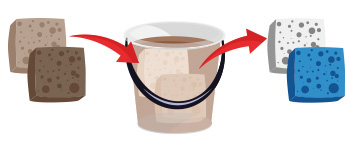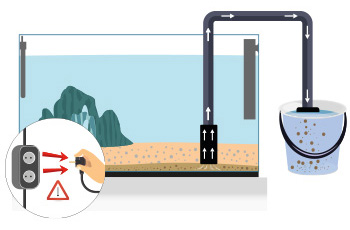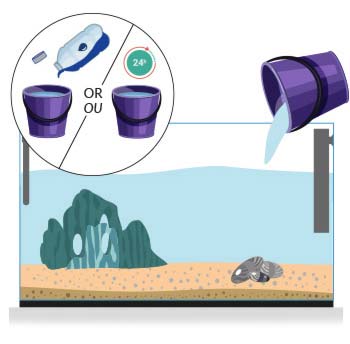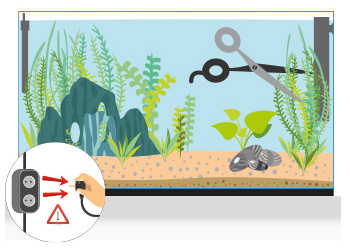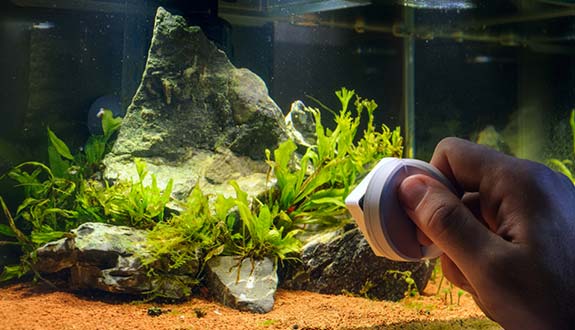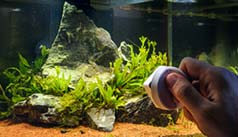

Our other guides (click on the thumbnail)
Hardware and security
Before cleaning or putting your hands in the water, disconnect all electrical equipment!
NEVER use containers that contain detergents or household cleaning products.
You will need:
Pipe / Siphon
Bucket or empty container
"New" or "Clean" water
Window squeegee or PVC card
Vacuum cleaner or bell for cleaning the floor
Pair of scissors
NO3 water test
Complementary water tests NO2 and NH3 (if necessary)
Other Ph, GH water tests ... (if necessary, depending on your population)
New Filter Foams for filter (if necessary)
Bundle for maintenance of aquarium plants (optional)
The quality of the water
In order to keep the water quality optimal, the bare minimum is to make a weekly water change. Indeed, even in aquariums equipped with a filter, it is necessary to renew part of the water regularly.
To explain what is really happening, let's summarise the nitrogen cycle that occurs in each aquarium. Feces from fish and other organic waste degrade to ammonia (NH3). This ammonia is converted by the bacteria contained in the filter and the soil into nitrites (NO2) and nitrate (NO3). Nitrate is consumed by plants and therefore serves as fertiliser, and so on.
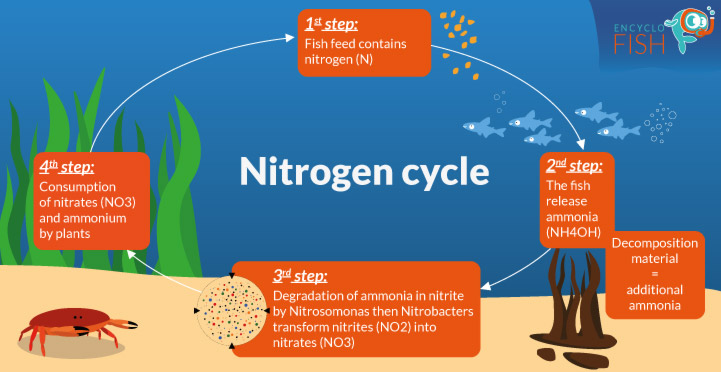
Nitrogen cycle
However, this system is rarely balanced in our aquariums because the density of living beings in relation to the volume is much higher than that found in nature. Thus, ammonia, nitrites and nitrates are very rapidly accumulated in the water. It goes without saying that these substances are very dangerous for our fish. It will therefore be necessary to renew part of the water regularly: we take the water from the polluted aquarium, and we replace it with the same volume of new and clean water.
To control the state of your water, there are tests in the form of strips or drops, to control different parameters (ph, Gh ...). To find out if your water needs a bigger change, or if you observe unusual behaviour in your fish, the nitrite or nitrate tests will help you to control the rate of water pollution, and to take the required measurements. The other parameters to be tested will be based on the requirements of your population.
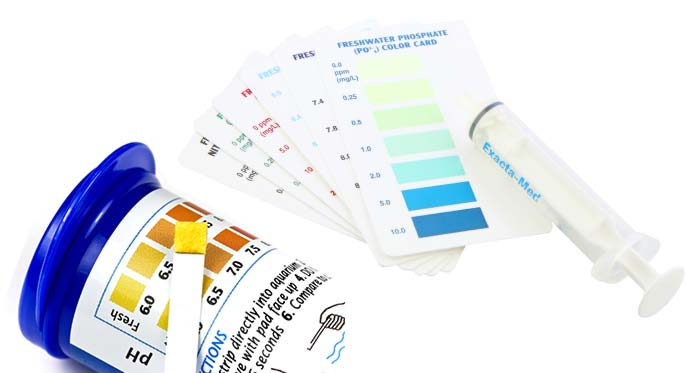
There are different solutions for testing water parameters
In general, we recommend changing a small volume (10%) each week rather than a larger volume once a month. Indeed, you risk less destabilising water parameters as well. In addition, it will significantly reduce water pollution. If you run out of time, you can limit the rate to 20% every 15 days, but water changes longer than 15 days should be avoided.
Concretely, place an empty bucket under the water level of the aquarium. Plunge a pipe into your aquarium and hold it in the empty bucket. Start the transfer by sucking in the air with your mouth so that the water begins to flow into the pipe. Your aspiration of polluted water begins! Keep this water to clean the filter when necessary. You can equip this hose with a priming system ("pear") and a strainer to avoid sucking a too curious fish!
Fill in the level with fresh water previously prepared. Remember to adjust the chemical composition and temperature of the replacement water so that it is identical to the one already present in the aquarium. Also beware of the presence of chlorine in the water of our faucets: use water conditioners (which will also neutralise the heavy metals) or let the new water rest 24 / 48h (the chlorine evaporates naturally). When you add the new water, pour it in your hand and over the aquarium to avoid digging the substrate and disturb the decoration. You can also put the bucket on the lid (if it is strong enough) and use a hose so that the water flows gently.
Floor cleaning
Soil cleaning, although necessary, should be done sparingly. Indeed, doing it too often can slow down or destroy the good bacteria responsible for the nitrogen cycle.
You can siphon the bulk of garbage accumulated at the bottom of each water change (every week) by shaving the substrate with your pipe, without touching it.
Deep cleaning, using a bell or vacuum cleaner, will be done once or twice a month. For this, prime the suction and push the bell into the ground a few millimeters (without going to the nutritive soil layer) by making small rotary movements. This type of cleaning makes it possible to separate the elements of the soil. The heavier ones like sand and gravel will fall, while the lighter (organic waste) will be really sucked up.
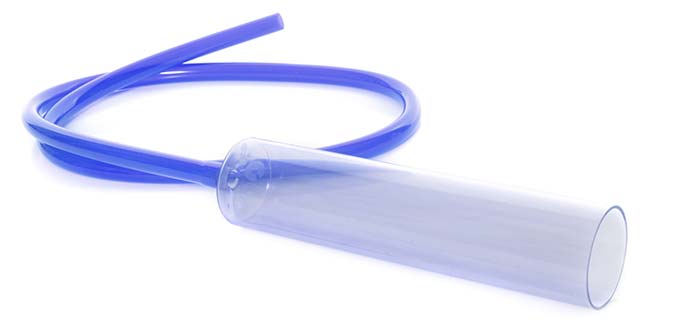
Bell for cleaning the bottom of the aquarium
Filter cleaning
It is very important to clean the filter once a month (no more, so as not to damage the bacterial colonies needed for the nitrogen cycle) so that it does not become dirty.
First, take the water from the dirty aquarium, for your water change, but do not discard it, keep it in a bucket.
Open the compartments to recover the filter. Rinse these in a bucket containing the aquarium water to remove the bulk of the dirt, pressing them like sponges until they are clean. Be careful, if you clean the foam under tap water, chlorine destroys the good bacteria found there.
If you wish to replace a part of the filtering mass with a new one, make it up to 50% maximum of its totality. The other half will have to be preserved to keep the continuity of the bacterial action.
Thoroughly clean the compartments and reinstall the filter in the corresponding compartments. Put the compartments back into the filter housing. Your filter is cleaned!
Note that bacterial colonies are weakened after this cleaning. Reduce fish feeding 2 to 3 days after cleaning in order for it to stabilise and recover.
Plants
Prune your plants when it seems necessary: to remove the excess, to remove dead leaves or those that carry too much algae ... Each plant must be maintained according to the specificities of its species. For more information, refer to the plant maintenance sheets. It can also be useful to make a contribution with a fertiliser, always according to the context and the species of plants present in your aquarium.
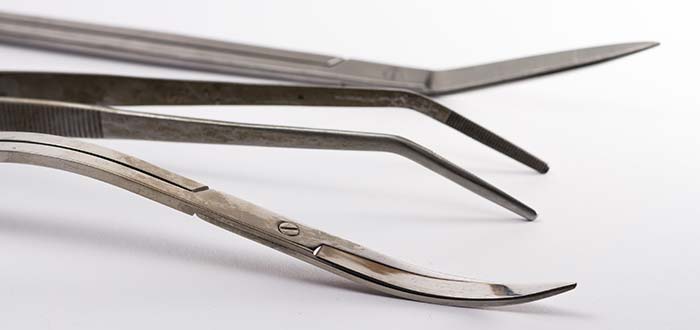
Precision tools for asquascaping
Windows
If you notice that the algae appear on your glass, clean using squeegee or magnets sold for this purpose. We advise you to carry out this cleaning regularly, even before the appearance of the algae. It's easier and faster than waiting until your window is completely covered with seaweed!
Little trick: you can use cotton wool or a PVC card (like a loyalty card, phone card...) that clean the windows very well without scratching them.
Be careful that no grain of sand or gravel gets caught between the glass and your cleaning tool as this could very quickly cause irreversible scratches!
Summary
Everyday:
check the water temperature
check the health of the fish
check that the equipment is working properly
add liquid fertiliser if necessary (very planted tank).
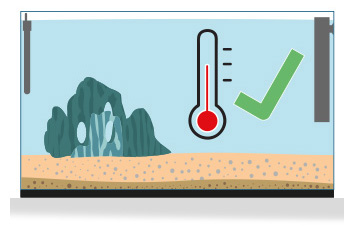
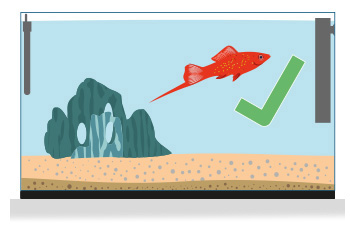
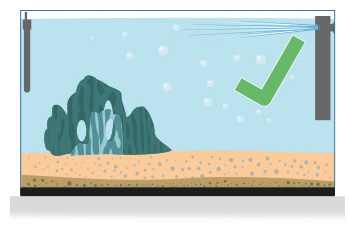
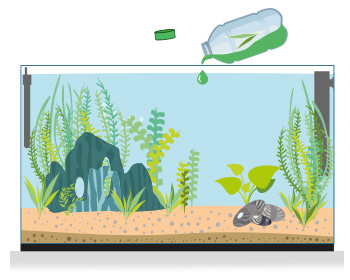
Every week:
make a water change of 10 to 25% (according to your population) by siphoning wast accumulated on the substrate.
remove the plants or dead leaves
clean the windows if necessary
control the level of nitrates
add liquid fertiliser if necessary (for a very planted tank)
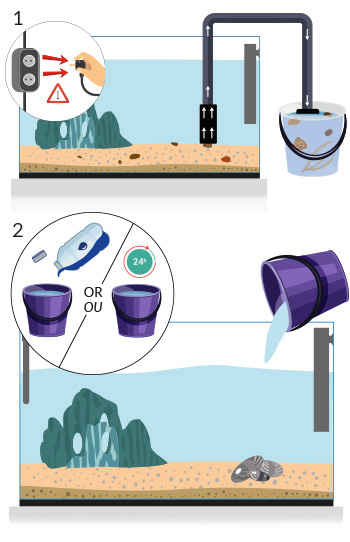
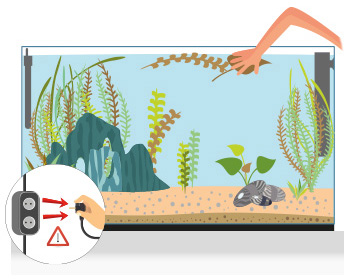
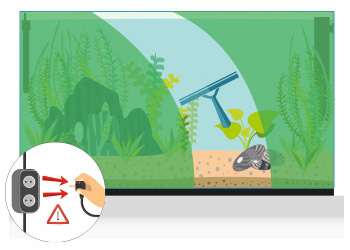
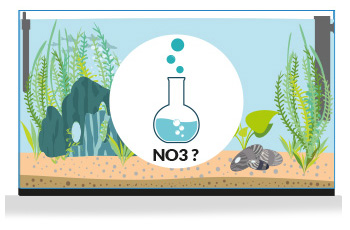

Every month:
clean the filter
clean the floor with a vacuum cleaner or bell
make a water change of 10 to 25% (depending on your population)
prune the plants
control the level of nitrates
clean the windows if necessary
add liquid fertiliser if necessary
